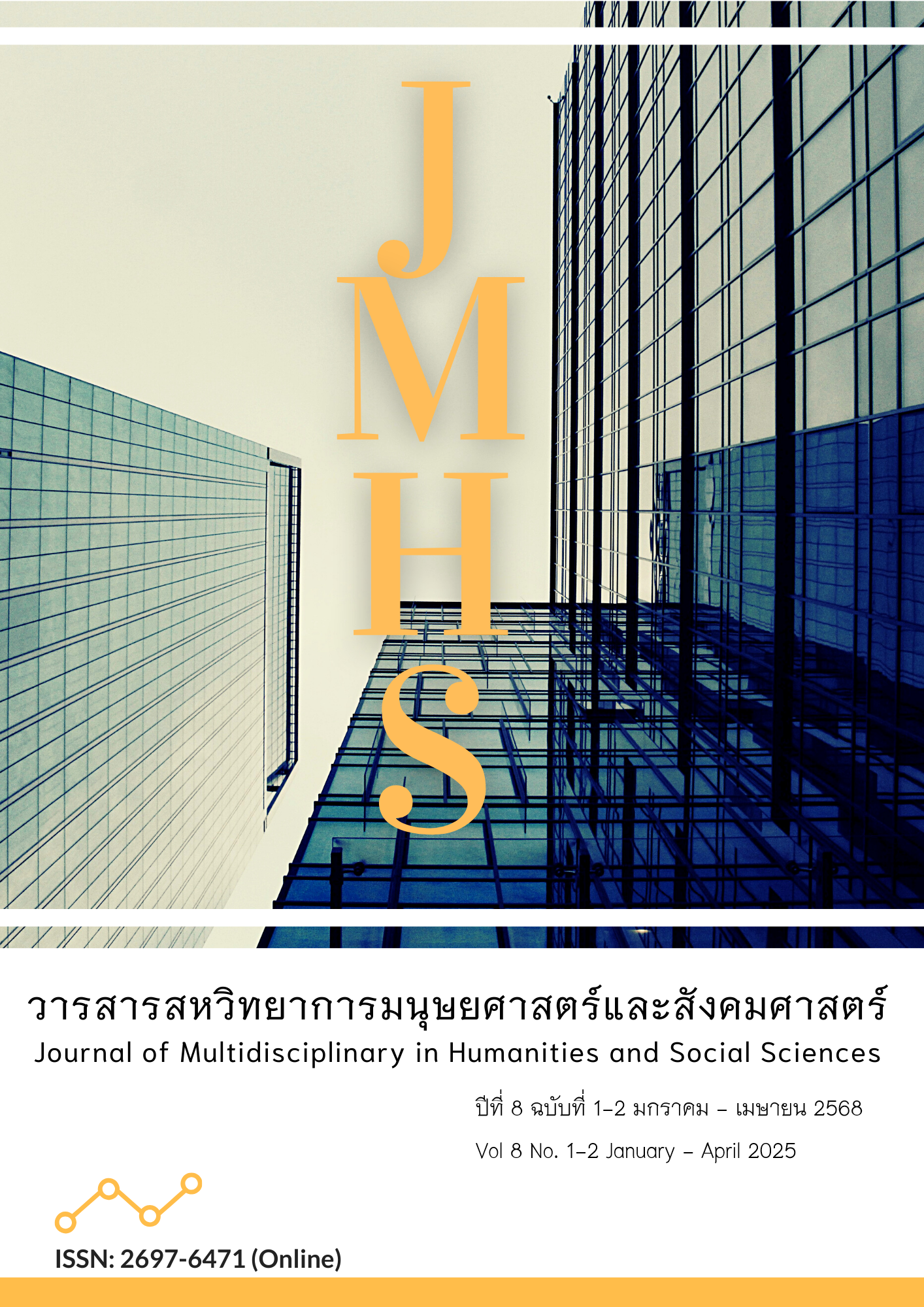การพัฒนารูปแบบการจัดการท่องเที่ยวสีขาวโดยการใช้เทคโนโลยีสารสนเทศของชุมชนหนองบัว จังหวัดจันทบุรี
Main Article Content
บทคัดย่อ
บทความนี้มีวัตถุประสงค์เพื่อ 1) ศึกษาผลกระทบของการท่องเที่ยวที่มีต่อวิถีชีวิตของคนในชุมชนหนองบัว จังหวัดจันทบุรี และ 2) สังเคราะห์รูปแบบการจัดการท่องเที่ยวสีขาวโดยการใช้เทคโนโลยีสารสนเทศของชุมชนหนองบัว จังหวัดจันทบุรี รูปแบบการวิจัยเป็นการวิจัยและพัฒนาโดยใช้กระบวนการวิจัยแบบผสมผสาน โดยศึกษาจากคนที่มีส่วนได้ส่วนเสียกับการท่องเที่ยวภายในชุมชนหนองบัว จังหวัดจันทบุรี อายุตั้งแต่ 20 ปีขึ้นไป จำนวน 100 คน ด้วยวิธีการคัดเลือกแบบเฉพาะเจาะจง ใช้แบบสอบถามเป็นเครื่องมือในการเก็บรวบรวมข้อมูล วิเคราะห์ข้อมูลทางสถิติแบบพรรณนาร่วมกับวิธีการวิจัยเชิงคุณภาพ จากการวิเคราะห์เอกสาร งานวิจัยที่เกี่ยวข้อง และแบบสัมภาษณ์ สรุปผลการวิเคราะห์ข้อมูล ดังนี้ 1) ผลกระทบของการท่องเที่ยวที่มีต่อวิถีชีวิตของคนในชุมชนหนองบัว จังหวัดจันทบุรี ทัศนคติของคนในชุมชนส่วนใหญ่เกิดความไม่แน่ใจว่าจะได้รับประโยชน์จากการท่องเที่ยวภายในชุมชนหนองบัว แต่ก็เห็นด้วยกับการได้รับประโยชน์จากการท่องเที่ยวด้านอาชีพ ในด้านเศรษฐกิจและสังคมเห็นด้วยกับการทำให้คนในชุมชนมีความเป็นอยู่ที่ดีขึ้น ด้านสิ่งที่ควรได้รับการพัฒนาส่วนใหญ่เห็นด้วยกับการจัดสถานที่จอดรถ ด้านผลกระทบจากการพัฒนาชุมชนให้เป็นแหล่งท่องเที่ยว ส่วนใหญ่ไม่เห็นด้วยกับผลกระทบในเรื่องของการทำให้วิถีชีวิตแย่ลง และ 2) ผลการสังเคราะห์รูปแบบการจัดการท่องเที่ยวสีขาวโดยการใช้เทคโนโลยีสารสนเทศชุมชนหนองบัว จังหวัดจันทบุรี “BCG2DCA Model” ประกอบด้วย 1) Bio Tourism (การท่องเที่ยวชีวภาพ) 2) Circular Tourism (การท่องเที่ยวแบบหมุนเวียน) 3) Green Economy (เศรษฐกิจสีเขียว) 4) Data Management
(การจัดการข้อมูล) 5) Digital Marketing (การตลาดดิจิทัล) 6) Community Empowerment (พลังชุมชน) 7) Awareness (ตระหนักรู้)
Article Details

This work is licensed under a Creative Commons Attribution-NonCommercial-NoDerivatives 4.0 International License.
ทัศนะและความคิดเห็นที่ปรากฏในวารสาร ถือเป็นความรับผิดชอบของผู้เขียนบทความนั้น และไม่ถือเป็นทัศนะและความรับผิดชอบของกองบรรณาธิการ
References
Bairachna, K., & Krupitsa, I. (2024). Use of artificial intelligence and big data in tourist destination management. Ukraïnsʹkij žurnal prikladnoï ekonomìki, (3), 252-255. https://doi.org/ 10.36887/2415-8453-2024-3-44
Benckendorff, P., Pauline, J., Sheldon., Daniel, R., Fesenmaier. (2014). Sustainable tourism and information technology. In book: Tourism information technology (pp.308-335). https://doi.org/10.1079/9781780641850.0308
Best, J. W. (1977). Research in education. New Jersy: Prentice Hall.
Cronbach, L. J. (1951). Coefficient alpha and the internal structure of tests. Psychometrika, 16, 297–334. ttps://doi.org/10.1007/BF02310555
Dushkova, D., & Ivlieva, O. (2024). Empowering communities to act for a change: a review of the community empowerment programs towards sustainability and resilience. Sustainability, 16(19), 8700. https://doi.org/10.3390/su16198700
Faculty of Informatics. (2018). Computers and information technology in daily life. Sakaeo: Burapha University.
Gantait, A., Mathew R., Chatterjee, P., & Singh, K. (2024). Community-based tourism as a sustainable direction for the tourism industry: evidence from the Indian Sundarbans. United States: IGI Global.
Harris, J. M. (2023). Green economy. In Elgar Encyclopedia of Ecological Economics (pp. 284-288). Edward Elgar Publishing.
Hutnaleontina, P.N., Bendesa, I.K.G., & Yasa, I.G.W.M. (2022). Correlation of community-based tourism with sustainable development to improve community welfare: a review. International Journal of Applied Sciences in Tourism and Events, 6(2), 184–194. DOI:10.31940/ijaste.v6i2.183-193
Klinmuenwai, K., & Sucharitkul, J. (2022). The impact of tourism affects the local community of Khong District, Nakhon Ratchasima Province. Rajapark Journal, 16(44), 56-72. Retrieved from https://so05.tci-thaijo.org/index.php/RJPJ/article/view/255060
Likert, R. (1967). “The method of constructing and attitude scale”, In Attitude Theory and Measurement. (pp. 90-95). New York: Wiley & Son.
Mony, F., Azuz, F., Zakaria, S., Marasabessy, A., & Kaisupy, T. (2023). The impact of community-based tourism development on the socio-economic dimensions of local communities in the coastal area of Ambon Island. Technium Social Sciences Journal, 47(1), 269–278. https://doi.org/10.47577/tssj.v47i1.9465
Nassanbekova, S., & Yeshenkulova, G. (2022). Mapping analysis of the research trends on digital technologies and circular economy in tourism. Journal of Environmental Management and Tourism, 13(7), 2048-2048. https://doi.org/10.14505/jemt.v13.7(63).24
National Tourism Policy Committee. (2023). National tourism development plan 3rd (2023-2027). Bangkok: Ministry of Tourism and Sports.
Nongbua Subdistrict Municipality. (2024). Demographic information. Chanthaburi: Ministry of Interior.
Nopiyani, N.M.S., & Wirawan, I. M.A. (2021). The impact of tourism on the quality of life of communities in tourist destination areas: a systematic review. Open Access Maced J Med Sci. 19(8), 129-136. https://doi.org/10.3889/oamjms.2021.5966
Office of Community Based Tourism. (2015). Community based tourism. Bangkok: Designated Areas for Sustainable Tourism Administration (Public Organization).
Office of the National Economic and Social Development Board. (2023). The thirteenth national economic and social development plan (2023-2027). Bangkok: Office of the National Economic and Social Development Council.
Office of the Permanent Secretary. (2023). Sustainable tourism strategic plan white tourism to BCG in action (2023-2027). Bangkok: Ministry of Tourism and Sports.
Rico, S., & Peterek, M. (2024). empowering rural communities: a theoretical approach to sustainable tourism through community-based development. Technical Transactions, 121(1). https://doi.org/10.37705/TechTrans/e2024005
Safonov, Y., Kopothy, O, II., & Konarivska, O, B. (2024). Digitalisation as a marketing management tool in the tourism industry. Baltic Journal of Economic Studies, 10(3), 295-303. DOI:10.30525/2256-0742/2024-10-3-295-303
Sharafuddin, M. A., Madhavan, M., & Wangtueai, S. (2024). Assessing the effectiveness of digital marketing in enhancing tourist experiences and satisfaction: a study of Thailand’s tourism services. Administrative Sciences, 14(11), 273. https://doi.org/10.3390/admsci14110273
Singh, A., Agrawal, A., & Mishra, M., (2015). Information technology: past, present and future. Bilingual International Conference on Information Technology. (pp. 14-20). DESIDOC.
Takuli, S., Rawal, Y.S., & Takuli, S.S., (2022). A review on effect of sustainable tourism on host community. Retrieved from https://books.aijr.org/index.php/press/catalog/book/134/chapter/1753
The Government Public Relations Department. (2024). Experience the way of life community charm: strange dessert community along Nong Bua canal, Chanthaburi province. Bangkok: Office of the Prime Minister.
Vallakitkasemsakul, S. (2024). Methodology in behavioral science and social sciences. Udonthani: Uksornsilp.
Wani, Z. A., & Pant, S. (2023). Status of biodiversity in a protected area of Kashmir Himalaya: Gulmarg wildlife sanctuary. Nordic Journal of Botany, (7). https://doi.org/10.1111/njb.03982
Xiang, L. (2024). Development of digital learning platform to boost Chinese children’s mental health awareness: experts’ evaluation. International Journal of Religion, 5(10), 5448-5460. https://doi.org/10.61707/vk5s3z25

